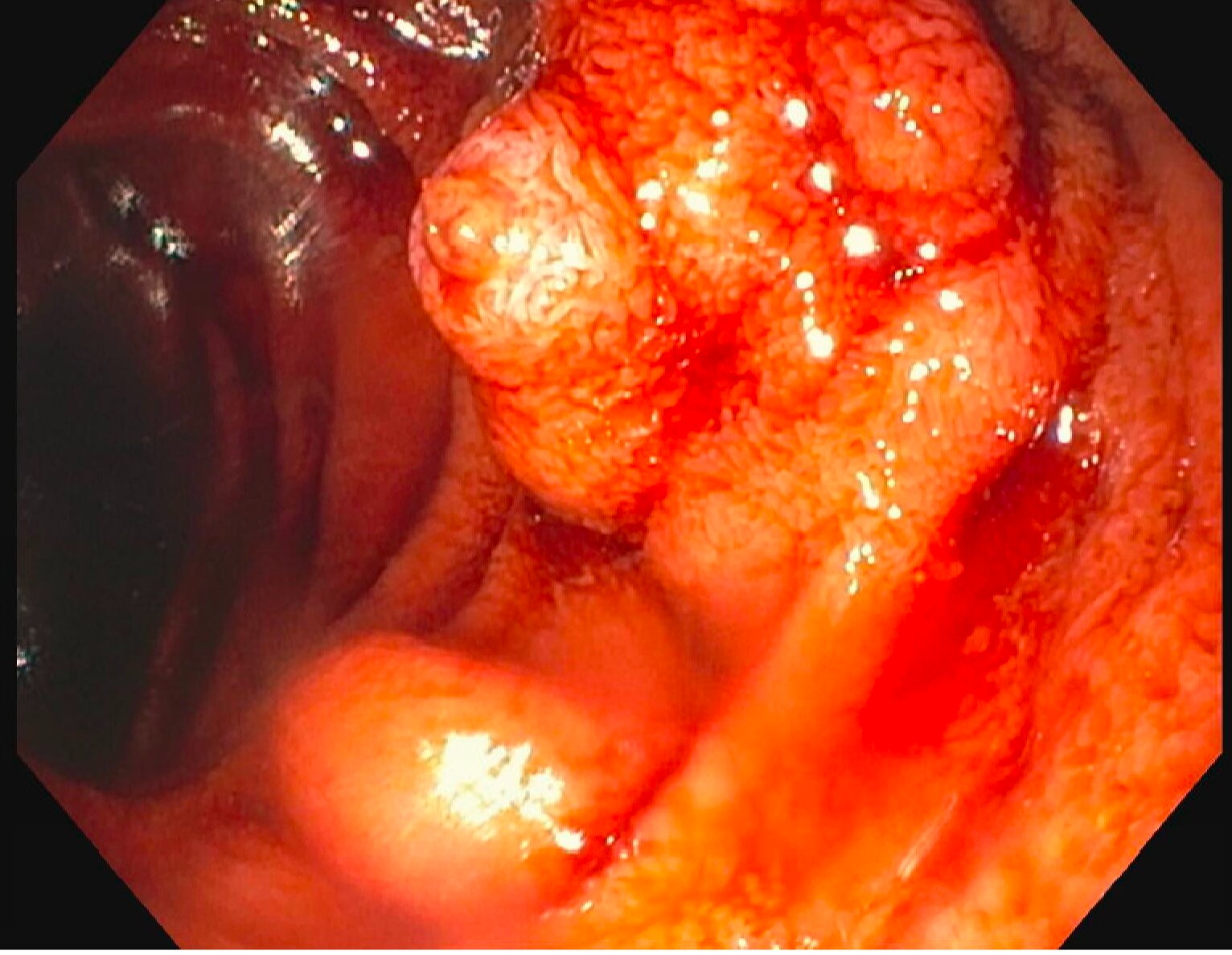Monday Poster Session
Category: GI Bleeding
P2071 - Bleeding Duodenal Varices Masquerading as Lower Gastrointestinal Bleeding
Monday, October 23, 2023
10:30 AM - 4:15 PM PT
Location: Exhibit Hall

Has Audio

Olachi Egbo, MD
Aurora Medical Center Oshkosh
Oshkosh, WI
Presenting Author(s)
Olachi Egbo, MD1, Onyinye Ugonabo, MD2, Joseph O. Atarere, MD, MPH3, Ebehiwele Ebhohon, MD4
1Aurora Medical Center Oshkosh, Oshkosh, WI; 2Marshall University Joan C. Edwards School of Medicine, Huntington, WV; 3MedStar Health, Baltimore, MD; 4Lincoln Medical Center, Bronx, NY
Introduction: Duodenal varices, a rare cause of gastrointestinal bleeding (GIB), occur due to portal hypertension. When bleeding occurs, it can be severe and life-threatening. Diagnosis and management can be particularly challenging when dealing with lesions in the distal part of the duodenum. Here, we present a case of duodenal variceal bleeding who presented initially with a mimic of lower GIB.
Case Description/Methods: We discuss a case of a 53-year-old male with a history of severe obesity, alcohol dependence, and alcoholic liver cirrhosis presented with sudden-onset abdominal pain, significant hematochezia, and lightheadedness. On initial evaluation, a physical examination revealed severe tachycardia, low-normal blood pressure, and active rectal bleeding. Labs noted hemoglobin of 11.8 g/dL (baseline 15g/dL) and elevated lactic acid of 4 mmol/L. PT/INR, BUN, and creatinine were within normal range. A computed tomography (CT) angiogram of the abdomen revealed an abnormal number of collateral veins around the distal duodenum and a questionable right portal vein stenosis or short segment thrombus, hepatic steatosis with findings highly concerning for underlying cirrhosis, but no features suggestive of active bleeding. Immediate resuscitation measures were implemented, including transfusion of packed red cells and administering pantoprazole and octreotide drips, and intravenous antibiotics. The patient was promptly taken to the endoscopy suite, where upper endoscopy revealed actively bleeding varices in the third portion of the duodenum. Successful sclerosing therapy was performed to achieve hemostasis. Considering the risk of rebleeding, a Balloon-Occluded Retrograde Transvenous Obliteration (BRTO) followed by Transjugular Intrahepatic Portosystemic Shunt (TIPS) procedure was performed without complications. The patient remained stable throughout the hospital stay and was subsequently discharged.
Discussion: This case report emphasizes the importance of considering duodenal variceal bleeding in patients with portal hypertension presenting with GIB regardless of symptoms. Prompt recognition, resuscitation, endoscopic intervention, and appropriate adjunctive therapies are essential for successful management. Collaboration between different specialties and further research is essential to enhance our understanding of this rare entity and improve patient outcomes.

Disclosures:
Olachi Egbo, MD1, Onyinye Ugonabo, MD2, Joseph O. Atarere, MD, MPH3, Ebehiwele Ebhohon, MD4. P2071 - Bleeding Duodenal Varices Masquerading as Lower Gastrointestinal Bleeding, ACG 2023 Annual Scientific Meeting Abstracts. Vancouver, BC, Canada: American College of Gastroenterology.
1Aurora Medical Center Oshkosh, Oshkosh, WI; 2Marshall University Joan C. Edwards School of Medicine, Huntington, WV; 3MedStar Health, Baltimore, MD; 4Lincoln Medical Center, Bronx, NY
Introduction: Duodenal varices, a rare cause of gastrointestinal bleeding (GIB), occur due to portal hypertension. When bleeding occurs, it can be severe and life-threatening. Diagnosis and management can be particularly challenging when dealing with lesions in the distal part of the duodenum. Here, we present a case of duodenal variceal bleeding who presented initially with a mimic of lower GIB.
Case Description/Methods: We discuss a case of a 53-year-old male with a history of severe obesity, alcohol dependence, and alcoholic liver cirrhosis presented with sudden-onset abdominal pain, significant hematochezia, and lightheadedness. On initial evaluation, a physical examination revealed severe tachycardia, low-normal blood pressure, and active rectal bleeding. Labs noted hemoglobin of 11.8 g/dL (baseline 15g/dL) and elevated lactic acid of 4 mmol/L. PT/INR, BUN, and creatinine were within normal range. A computed tomography (CT) angiogram of the abdomen revealed an abnormal number of collateral veins around the distal duodenum and a questionable right portal vein stenosis or short segment thrombus, hepatic steatosis with findings highly concerning for underlying cirrhosis, but no features suggestive of active bleeding. Immediate resuscitation measures were implemented, including transfusion of packed red cells and administering pantoprazole and octreotide drips, and intravenous antibiotics. The patient was promptly taken to the endoscopy suite, where upper endoscopy revealed actively bleeding varices in the third portion of the duodenum. Successful sclerosing therapy was performed to achieve hemostasis. Considering the risk of rebleeding, a Balloon-Occluded Retrograde Transvenous Obliteration (BRTO) followed by Transjugular Intrahepatic Portosystemic Shunt (TIPS) procedure was performed without complications. The patient remained stable throughout the hospital stay and was subsequently discharged.
Discussion: This case report emphasizes the importance of considering duodenal variceal bleeding in patients with portal hypertension presenting with GIB regardless of symptoms. Prompt recognition, resuscitation, endoscopic intervention, and appropriate adjunctive therapies are essential for successful management. Collaboration between different specialties and further research is essential to enhance our understanding of this rare entity and improve patient outcomes.

Figure: Image a
Disclosures:
Olachi Egbo indicated no relevant financial relationships.
Onyinye Ugonabo indicated no relevant financial relationships.
Joseph Atarere indicated no relevant financial relationships.
Ebehiwele Ebhohon indicated no relevant financial relationships.
Olachi Egbo, MD1, Onyinye Ugonabo, MD2, Joseph O. Atarere, MD, MPH3, Ebehiwele Ebhohon, MD4. P2071 - Bleeding Duodenal Varices Masquerading as Lower Gastrointestinal Bleeding, ACG 2023 Annual Scientific Meeting Abstracts. Vancouver, BC, Canada: American College of Gastroenterology.
